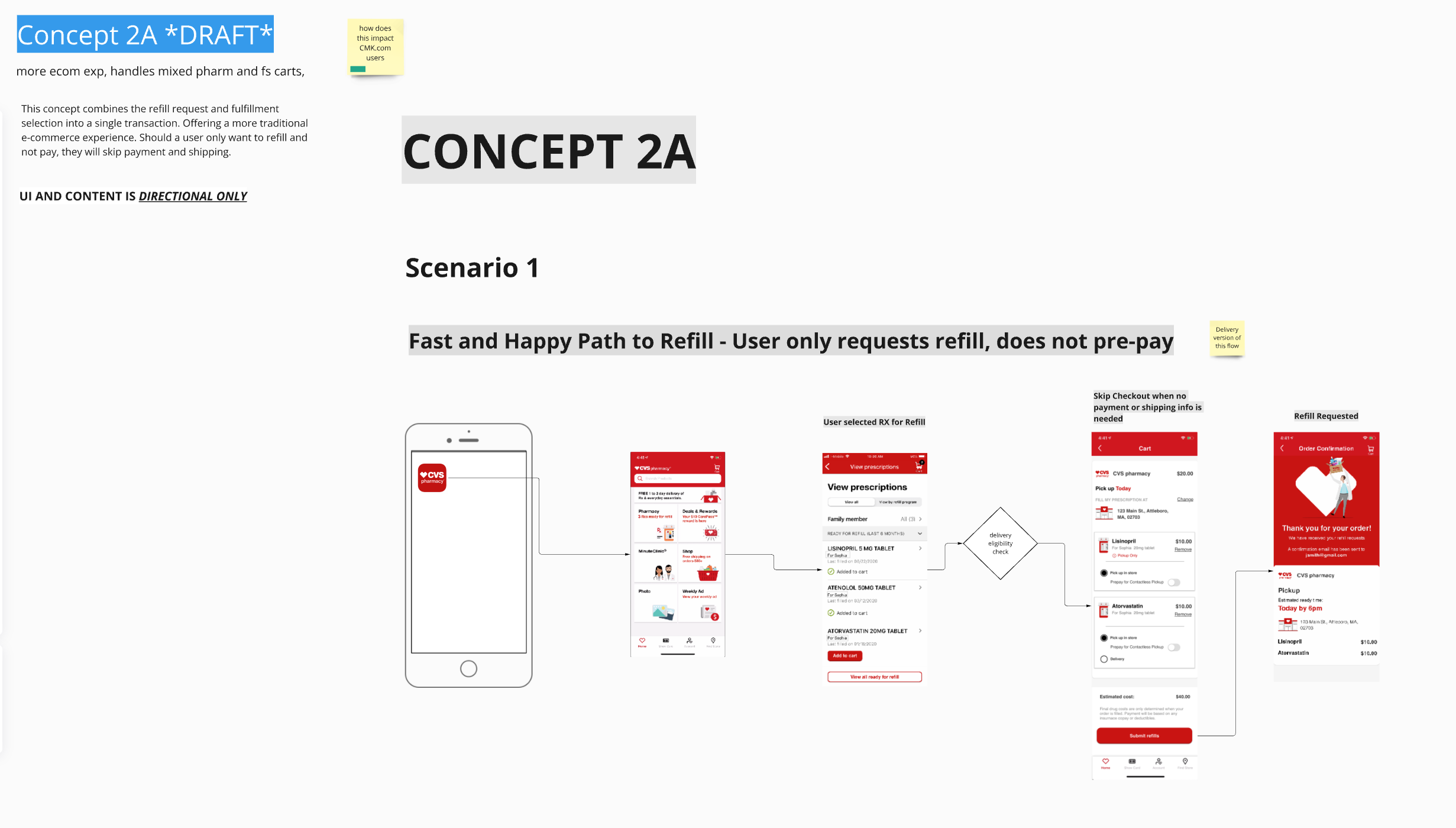Pharmacy Delivery Services
My role : Product designer, Research and Customer experience strategy on CVS Health app and mobile web
The Opportunity
Millions of patients were stuck at home during quarantine, many of them unaware that CVS offered free prescription delivery—a service that could have made a huge difference in their lives. This gap in awareness meant that a vital resource was going underutilized at a time when people needed it most. I knew I had to step in and change that.
My first priority was getting the word out. I worked to create a strategy that would reach patients where they were—whether through digital channels, in-store communications, or direct outreach. But raising awareness was just one part of the solution. I also needed to make the process as straightforward as possible, so patients could easily access the care they needed without jumping through hoops.
This required close collaboration between marketing, pharmacy, and tech teams. By bringing everyone to the table, I was able to streamline the experience from start to finish. I simplified the steps for signing up for delivery and made sure the messaging was clear and patient-focused. My goal was to not only inform patients about this service but to make it feel like a natural, stress-free part of their care.
In the end, it wasn’t just about offering a service—it was about showing patients that we were there for them, even during a difficult time. By working closely with the teams and staying aligned on our goals, I was able to make a real impact, ensuring that more patients could get their prescriptions safely and conveniently. This effort didn’t just solve an immediate problem; it helped build stronger, more trusting relationships with our patients that would last well beyond the pandemic.
The Approach
To really tackle the issue, I decided to take a step back, apply service design best practices, and look at the entire patient journey—from the moment they first interact with the pharmacy to when their prescription gets delivered to their door. This broader view helped me uncover a system problem that had been around for a while and was causing a major gap in the experience. It was eye-opening to see how something so ingrained was affecting our patients.
Next, I brought everyone together for a cross-functional blueprinting workshop, followed by a five-day design sprint. I had teams from retail, pharmacy, and tech all in the same room, which was key to figuring out the root of the problem. I discovered that patients weren’t getting the option for delivery when they requested a refill because the final cost of the prescription wasn’t available until after it was processed. This gap in timing meant patients missed out on a service they really needed. By zeroing in on this issue, I was able to tweak the process to better fit patient needs while still working within the existing technical limits.
Once I identified the core problem, my focus shifted to making the patient experience smoother and more transparent. I realized that patients needed clearer information about their insurance coverage and final costs, plus a better understanding of how prices might change. To get this right, I conducted a lot of customer interviews to hear directly from patients about their concerns and what they wanted. These insights were invaluable, helping me shape solutions that really resonated with them.
Throughout all of this, the key was collaboration. By working closely with all the different teams, I not only fixed a big issue but also laid the groundwork for a more empathetic and effective patient experience.
Design Workshops
After the rapid design phase, I brought together design, tech, data, and product stakeholders for a “5 Day Design Sprint”—a series of hands-on design thinking workshops. These sessions were crucial for aligning on our project goals, mapping out the primary user journey, and brainstorming innovative ideas. We also prioritized features to ensure we were delivering real value in the new experience.
As the project progressed, I continued to lead similar workshops at the start of each sprint. These sessions kept everyone on the same page, allowing us to collaborate effectively and consistently generate creative solutions that met our objectives.
The Vision
By tackling price transparency head-on and implementing a two-way SMS system to handle price changes, I was able to significantly enhance the delivery process. This improvement wasn't just about logistics—it was about providing essential support to patients when they needed it most. By making the process smoother and more transparent, I helped foster a sense of trust and loyalty among customers that extended well beyond the immediate challenges.
In addition to this, I took steps to enhance order tracking and broaden store pickup options to better serve all pharmacy customers. My goal was to create a more convenient and reliable experience, one that was truly tailored to their needs. By collaborating closely with various teams, I ensured that these improvements were aligned with what patients were looking for, making their interactions with the pharmacy more seamless and stress-free. This approach not only addressed immediate concerns but also strengthened the overall relationship with our patients, showing them that their needs were at the heart of everything we did.
Looking Forward
With everyone on board—from development to product teams—I helped shape the long-term roadmap, making sure our strategy was both flexible and effective. By working closely together, we planned a phased rollout that let us test, learn, and tweak the solution as we went. This collaboration not only sparked innovation but also ensured we were always in tune with our patients' and partners' needs, delivering a solution that truly worked for them.












